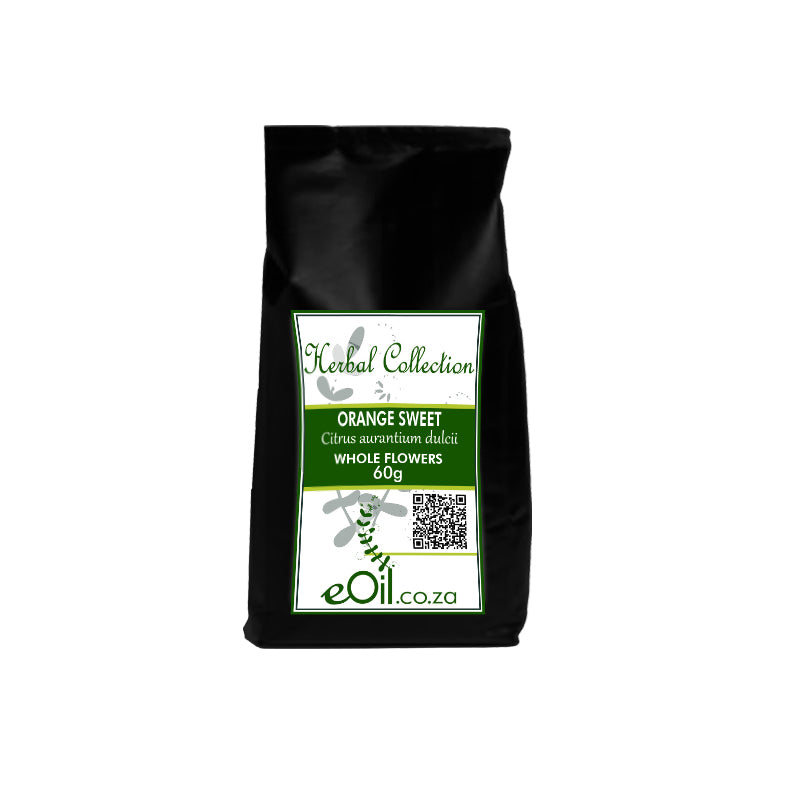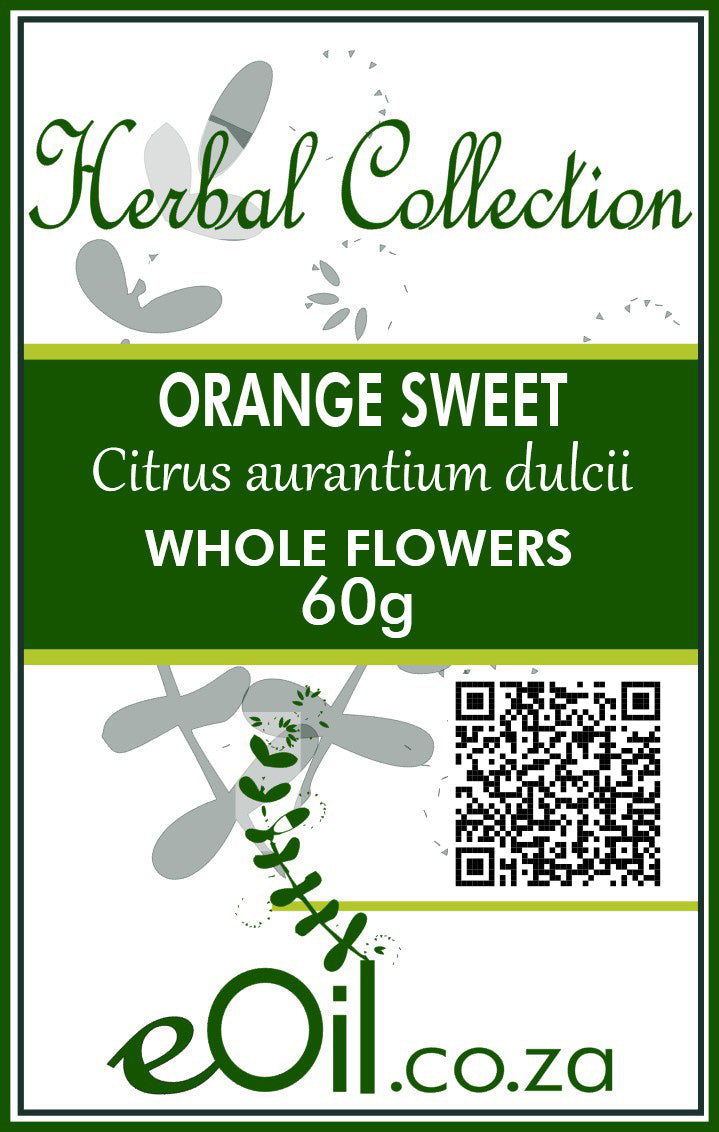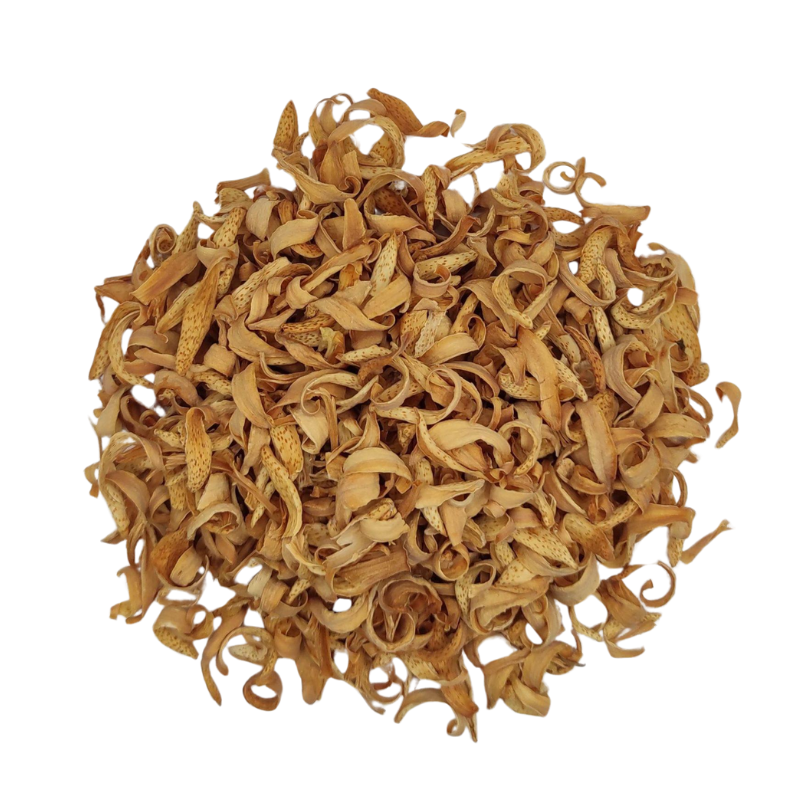Orange Flowers Sweet Whole Dried - Herbal Collection
Orange Flowers Sweet Whole Dried - Herbal Collection - 75 GR is backordered and will ship as soon as it is back in stock.
Description
Description
Citrus aurantium
Orange Flowers Sweet Whole Dried - 60 g - Herbal Collection
TRADITIONALLY USED FOR
May help with
- antibacterial
- sedative
- cooking
- potpourri
- candle making
INFORMATION
plant name
Bitter Orange, Bitter Orange
- For essential oils: neroli (flowers), orange tree petit grain or petit grain (leaves and flower bud)
International Latin denomination
Citrus aurantium L. ssp aurantium Engler and Citrus aurantium L. ssp. amara Engler, synonyms Citrus bigaradia Duch., Citrus vulgaris Risso
botanical family
Rutaceae
Description and habitat
- Shrub up to 5-10 m tall, leaves entire, elliptical, with winged petiole
- Very pure white flowers with a pleasant sweet smell
- Southern Europe and regions with a subtropical climate (the drug is generally imported from Spain and Mexico)
History and tradition
- The genus Citrus ( Rutaceae ) originated in the Malay Archipelago over 20 million years ago
- Sour orange and sweet orange seem to be two very different species .
- The flowers give the essence of Neroli (named after Marie-Anne de La Trémoille, Princess of Ursins and Nerola, who popularized it and whose legend says she used it during the plague in the 17th century in Italy)
- The leaves and young twigs with fruits give the essence of petit grain
Parts used
- Flower, leaf, fruit, fruit peel
- Essential oil of flowers, zests, leaves
- candied fruit peel (orangeat)
Dosage forms available
- Essential oil of zest (essence of expression of fruit peels or essence of bitter orange )
- Essential oil of leaves and flower bud ( small grain )
- Flower essential oil ( Neroli )
Usual dosages
Composition
Main components of the plant
- Flavonoids : tangeretin , nobiletin , naringin and naringenin , heptamethoxyflavone
- Alkaloids : synephrine and octopamine in the bark
- Essential oil of different composition depending on the organ:
- Bark essential oil (peel): limonene essence (85-90%), beta-myrcene , decanal , citrals , meranzine, esters ( linalyl acetate , geranyl acetate , citronellyl acetate ); coumarins , carotenoids , vitamin C, flavanones , citroflavonoids , pectins
- Neroli essential oil (extracted from the flowers): linalool 30-45%, nerolidol , farnesol , linalyl acetate 2-15%, limonene , beta-pinene
- Leaf essential oil (Petitgrain): linalyl acetate 40-80%, linalool
Main components of buds or young shoots
Main components of essential oil
- Leaf essential oil ( small grain ):
- Esters (55-60%): linalyl acetate 40-80%, geranyl acetate 4%, neryl acetate 2%, alpha-terpinyl acetate
- Monoterpenols and alcohols (32%): linalool 25%, alpha-terpineol 5%, geraniol 3%, nerol < 2%, 4-terpineol , 3-hexen-1-ol , (E)-2-hexen-1-ol , 1-hexanol , gamma-terpineol
- Monoterpenes (8-9%): limonene 1%, cis-ocimene , trans-ocimene 2%, beta-myrcene 2%, beta-pinene 2%, para-cymene , delta-3-carene , alpha-pinene , sabinene , gamma-terpinene , camphene , alpha-phellandrene , terpinolene
- Sesquiterpenes (<1%): beta-caryophyllene , gama-elemene , trans-beta-farnesene , bicyclogermacrene
- Aldehydes (<1%): geranial , neral
- Sesquiterpenols (<1%): nerolidol
- Ketones (<1%): 6-methyl-5-hepten-2-one
- Nitrogen compound: Methyl N-methyl anthranilate < 1%
- Monoterpene oxides : 1.8 cineole , linalool oxide
- Neroli essential oil (extracted from the flowers):
- Monoterpenes ( limonene 15%, beta-pinene 15%, trans-beta-ocimene , cis-beta-ocimene , myrcene , sabinene , terpinolene )
- Monoterpenols ( mainly linalool 30-35%, alpha-terpineol , nerol , terpinene-4-ol )
- Terpene esters ( linalyl acetate , geranyl acetate , neryl acetate , terpenyl acetate )
- Sesquiterpenes ( beta-caryophyllene )
- Sesquiterpenols ( farnesol , nerolidol 2–10 %)
- Sesquiterpene aldehydes : farnesal
- Bark (rind) essential oil [1] , [2] , [3] , [4] , [5] :
- Limonene (85-90%), beta-myrcene , decanal , citrals , meranzine , esters ( linalyl acetate , geranyl acetate , citronellyl acetate )
- Coumarins , carotenoids , vitamin C, flavanones , citroflavonoids , pectins (in EO extracted by peel expression)
Properties
Plant properties
- Sheets :
- Central nervous system sedative by monoterpene alcohols and esters , antispasmodic, mild hypnotic
- Anticancer properties: tangeretin and nobiletin ( flavonoids ) inhibit carcinogen-induced mutagenesis and cancer cell division, heptamethoxyflavone slows Epstein-Barr virus activation, inhibits carcinogenesis and skin tumor promotion (mice)
- Flavonoids are lipid - lowering ( naringin and naringenin ) by enzymatic inhibition (acyl-coenzyme A cholesterol acyltransferase and coenzyme-3-hydroxy-3-methylglutaryl A-reductase)
- Flavonoids are inhibitors of adipocyte differentiation ( naringin , hesperidin , poncirin , isosiennsetin , hexamethoxyflavone , sineesytin , isoscutellarein , nobiletin , heptamethoxyflavone , 3-hydoxynobiletin , tangeretin , hydroxypentamethoxyflavone ) [ 6]
- Zests:
- Citrus peel powder is antibacterial against Salmonella typhi , Enterobacter spp , Aspergillus niger [7]
- Beware of the presence of synephrine with adrenergic properties
- Flowers:
- Sedatives
Bud properties
Properties of essential oil
- Petit grain ( essential oil of petit grain bigarade ):
- Calming the nervous system, sedative, anxiolytic [8] , [9] , [10] ,
- Anti-inflammatory on neuralgic phenomena (cervicodorsal arthritis, neuritis, painful articular rheumatism)
- Light sleeping pill
- Spasmolytic (nerve, thoracic, gynecological spasms)
- Vascular spasmolytic (mild coronary insufficiency)
- Improves arterial circulation
- Antiplethoric
- Mild anti-infective (respiratory tract conditions)
- Potentialities in resistant Staphylococcus aureus (MRSA) infections [11]
- Antiparasitic, larvicide on Anopheles stephensi [12]
- Zest ( essence of bitter orange ):
- Properties of d-limonene and citral , anticancer and antiviral [13]
- Sedative and anxiolytic [14]
- Antibacterial against pathogenic flora while respecting resident flora (microbiota) [15]
- Can be used in massage with an anxiolytic effect [16]
- Mild cholesterol lowering
- Adjuvant in dermatology (beware of photosensitizing risks)
- Flowers ( neroli essential oil )
- Tranquilizer, antispasmodic, mild antidepressant
- Analgesic and anti-inflammatory [17] ( linalool , linalyl acetate , nerolidol )
- Inhaling neroli essential oil helps relieve menopausal symptoms, reportedly increases sexual desire, reduces blood pressure in postmenopausal women [18]
- Improves symptoms of premenstrual syndrome, when inhaled [19] , [20] , potentiated by Damask rose essential oil [21]
- Neroli essential oil is anticonvulsant [ 22] , it is also antibacterial ( Pseudomonas aeruginosa ) and antifungal [23]
Directions
Indications of the whole plant (phytotherapy)
- Flowers:
- Nervousness, ease of falling asleep
- Sheets :
- Neurotonic states and minor sleep disturbances
- Excellent sedative for children
- Anxiety
- Zests:
- The use of citrus peel flavonoids in chemoprevention has been discussed
- In some commercial preparations for people who want to lose weight, caffeine is combined with bitter orange peel extract due to the presence of synephrine with adrenergic properties. The efficacy of this combination has not been demonstrated. In addition, it can cause heart problems similar to those caused by the combination ephedrine / caffeine
- The limit dose of p- synephrine has been set at 20 mg ANSES opinion on the risks associated with the presence in food supplements of p-synephrine or ingredients obtained from fruits of Citrus spp. containing
Indications of the bud (gemmotherapy)
Specific indications of essential oil (aromatherapy)
- Petit grain and neroli :
- Nervousness, ease of falling asleep, anxiety
- Inhalation of Citrus aurantium essential oil decreases anxiety and stress levels in patients undergoing coronary angiography [24]
- Neurotonic states and minor sleep disturbances
- Restless legs syndrome: foot massage with essential oils of Lavandula vera and Citrus aurantium improves sleep quality and restless legs syndrome [25]
- The aromatic massage of the legs with essential oils of Lavandula vera and Citrus aurantium significantly improves the quality of life of hemodialysis patients [26]
- Excellent sedatives for children
- Reactive nervous breakdown, sadness and melancholy, overwork, weariness
- Spasmophilia, autonomic dystonias
- Relieves the pain of childbirth [27]
- Topical use: skin conditions, acne, boils, facials
- Nervousness, ease of falling asleep, anxiety
- Zests:
- Intestinal dysbiosis
Known or suspected mode of action
- Anthranilic acid is responsible for the biosynthesis of benzodiazepines by certain fungi
- d-Limonene protects against cancerization of the skin, liver, breast and colon [28] , inhibits malignant cell growth [29] , [30] , [31]
- Linalool is analgesic , anti-inflammatory, anxiolytic [32] , inhibits the release of acetylcholine and reduces the opening time of the ion channels of the neuromuscular junction), antioxidant, hypnotic, anti-convulsant, hypothermic, local anesthetic, antiseptic, antiviral
Usual formulations
Regulations
- French Pharmacopoeia list A (leaf, flower, pericarp called "bark or zest")
Possible side effects and precautions for use
- The essential oil of zest is photosensitizing ( limonene and coumarins )
- The green fruit of Citrus aurantium L. ssp aurantium ( Citrus aurantium L. ssp amara ) is prohibited for sale ( Decision of April 12, 2012 prohibiting…green fruit of Citrus aurantium L. ssp aurantium ) because it contains synephrine , an agonist sympathetic alpha-adrenergic, pharmacologically related to ephedrine , the use of which in humans has been prohibited in France since October 2003 in view of its serious cardiovascular and neurological adverse effects
- Possibility of cardiac disorders with synephrine / caffeine combination , same with octopamine
- Food products must not contain more than 30 mg of synephrine (ie 500 mg of extract titrated at 6%) to be marketed. Synephrine is present in food, it would be disproportionate to completely ban it in food supplements (DGCCRF)
- Orange juice contains 15 to 27 mg/l of synephrine
Bibliographic references
- Aller↑ Bendaha, Hasnae & Bouchal, Btissam & El Mounsi, Ibrahim & Salhi, Amin & Berrabeh, Mohammed & El Bellaoui, Mohammed & Mimouni, Mostafa. (2016). Chemical composition, antioxidant, antibacterial and antifungal activities of peel essential oils of citrus aurantium grown in Eastern Morocco. The Pharmacy Letter. 8. 239-245.
- Aller↑ Jeannot V, Chahboun J, Russell D, Baret P. (2005). Quantification and determination of chemical composition of the essential oil extracted from natural orange blossom water (Citrus aurantium L. ssp. aurantium). International Journal of Aromatherapy. 15. 94-97. 10.1016/j.ijat.2005.03.012.
- Aller↑ Boussaada Olfa, Skoula Melpomeni, Kokkalou Eugene, Chemli R. (2013). Chemical Variability of Flowers, Leaves, and Peels Oils of Four Sour Orange Provenances. Journal of Essential Oil Bearing Plants. 10. 453-464. 10.1080/0972060X.2007.10643579.
- Aller↑ Carmen González-Mas M, Rambla Jose, López-Gresa M Pilar, Blázquez María, Granell Antonio. (2019). Volatile Compounds in Citrus Essential Oils: A Comprehensive Review. Frontiers in Plant Science. 10.10.3389/fpls.2019.00012.
- Aller↑ Ouedrhiri, W., Bouhdid, S., Balouiri, M., Lalami, AEO, Moja, S., Chahdi, FO, & Greche, H. (2015). Chemical composition of Citrus aurantium L. leaves and zest essential oils, their antioxidant, antibacterial single and combined effects. J. Chem. Pharma. Res, 7(1), 78-84.
- Aller↑ Kim G, Park H, Woo J, Kim M, Koh P, Min W, Ko Y, Kim C, Won C, Cho J. Citrus aurantium flavonoids inhibit adipogenesis through the Akt signaling pathway in 3T3-L1 cells. BMC Complementary and Alternative Medicine 2012, 12:31 (3 April 2012) Abstract: [1] , Provisional PDF: [2]
- Aller↑ Adeline Dorcas F, Sheila John, Estherlydia, Priya Iyer, Priyadarshini S. Study on the antimicrobial property of bitter orange (Citrus aurantium L.) Peel powder and developing recipes using the powder. International Journal of Home Science 2016; 2(2): 125-131 full text
- Aller↑ Goes TC, Antunes FD, Alves PB, Teixeira-Silva F. Effect of sweet orange aroma on experimental anxiety in humans. J Altern Complement Med. 2012 Aug;18(8):798-804. PMID 22849536
- Aller↑ Pultrini Ade M, Galindo LA, Costa M. Effects of the essential oil from Citrus aurantium L. in experimental anxiety models in mice. Life Sci. 2006 Mar 6;78(15):1720-5. PMID 16253279
- Aller↑ Carvalho-Freitas MI, Costa M. Anxiolytic and sedative effects of extracts and essential oil from Citrus aurantium L. Biol Pharm Bull. 2002 Dec;25(12):1629-33. PMID 12499653 full text
- Aller↑ Karthikeyan, Venkatachalam. (2014). Antibacterial activity of Citrus aurantium leaf essential oil against S.aureus and MRSA. Journal of Drug Discovery and Therapeutics 2 (22) 2014, 54-60. 2. 54-60. Full Text
- Aller↑ Sanei-Dehkordi, A., Sedaghat, MM, Vatandoost, H., & Abai, MR (2016). Chemical Compositions of the Peel Essential Oil of Citrus aurantium and Its Natural Larvicidal Activity against the Malaria Vector Anopheles stephensi (Diptera: Culicidae) in Comparison with Citrus paradisi. Journal of arthropod-borne diseases, 10(4), 577-585. PMID 28032110 full text
- Aller↑ Jyotsna A. Saonere Suryawanshi. An overview of Citrus aurantium used in treatment of various diseases. African Journal of Plant Science Vol. 5(7), p. 390-395, July 2011
- Aller↑ Costa CA, Cury TC, Cassettari BO, Takahira RK, Flório JC, Costa M. Citrus aurantium L. essential oil exhibits anxiolytic-like activity mediated by 5-HT1A-receptors and reduces cholesterol after repeated oral treatment. BMC Complementary and Alternative Medicine 2013, 13:42 (23 February 2013) Abstract Provisional PDF
- Aller↑ Hawrelak JA, Cattley T, Myers SP. Essential oils in the treatment of intestinal dysbiosis: A preliminary in vitro study. Altern Med Rev. 2009 Dec;14(4):380-4. PMID 20030464
- Aller↑ Jiro Imanishi, Hiroko Kuriyama, Ichiro Shigemori, Satoko Watanabe, Yuka Aihara, Masakazu Kita, Kiyoshi Sawai, Hiroo Nakajima, Noriko Yoshida, Masahiro Kunisawa, Masanori Kawase, Kenji Fukui. Anxiolytic Effect of Aromatherapy Massage in Patients with Breast Cancer. Evid Based Complement Alternate Med. 2009 March; 6(1): 123–128. Full Text
- Aller↑ Khodabakhsh P, Shafaroodi H, Asgarpanah J. Analgesic and anti-inflammatory activities of Citrus aurantium L. blossoms essential oil (neroli): involvement of the nitric oxide/cyclic-guanosine monophosphate pathway. J Nat Med. 2015 Jul;69(3):324-31. doi: 10.1007/s11418-015-0896-6. PMID 25762161 .
- Aller↑ Choi SY, Kang P, Lee HS, Seol GH. Effects of Inhalation of Essential Oil of Citrus aurantium L. var. amara on Menopausal Symptoms, Stress, and Estrogen in Postmenopausal Women: A Randomized Controlled Trial. Evidence-based Complementary and Alternative Medicine: eCAM. 2014;2014:796518. doi:10.1155/2014/796518. Full Text
- Aller↑ Heydari, N., Abootalebi, M., Tayebi, N., Hassanzadeh, F., Kasraeian, M., Emamghoreishi, M., & Akbarzadeh, M. (2019). The effect of aromatherapy on mental, physical symptoms, and social functions of females with premenstrual syndrome: A randomized clinical trial. Journal of family medicine and primary care, 8(9), 2990–2996. https://doi.org/10.4103/jfmpc.jfmpc_452_19 . PMID 31681680
- Aller↑ Heydari, N., Abootalebi, M., Jamalimoghadam, N., Kasraeian, M., Emamghoreishi, M., & Akbarzadeh, M. (2018). Investigation of the effect of aromatherapy with Citrus aurantium blossom essential oil on premenstrual syndrome in university students: A clinical trial study. Complementary therapies in clinical practice, 32, 1–5. https://doi.org/10.1016/j.ctcp.2018.04.006 . PMID 30057033
- Aller↑ Heydari N, Abootalebi M, Jamalimoghadam N, Kasraeian M, Emamghoreishi M, Akbarzaded M. Evaluation of aromatherapy with essential oils of Rosa damascena for the management of premenstrual syndrome. Int J Gynaecol Obstet. 2018 Aug;142(2):156-161. doi: 10.1002/ijgo.12534. PMID 29788545
- Aller↑ Azanchi T, Shafaroodi H, Asgarpanah J. Anticonvulsant activity of Citrus aurantium blossom essential oil (neroli): involvment of the GABAergic system. Nat Prod Common. 2014 Nov;9(11):1615-8. PMID 25532295
- Aller↑ Ammar AH, Bouajila J, Lebrihi A, Mathieu F, Romdhane M, Zagrouba F. Chemical composition and in vitro antimicrobial and antioxidant activities of Citrus aurantium l. flowers essential oil (Neroli oil). Pak J Biol Sci. 2012 Nov 1;15(21):1034-40. PMID 24163946
- Aller↑ Moradi K, Ashtarian H, Danzima NY, Saeedi H, Bijan B, Akbari F, Mohammadi MM. Essential Oil from Citrus aurantium Alleviates Anxiety of Patients Undergoing Coronary Angiography: A Single-Blind, Randomized Controlled Trial. Chin J Integr Med. 2021 Mar;27(3):177-182. doi: 10.1007/s11655-020-3266-5. PMID 32572778 .
- Aller↑ Oshvandi K, Mirzajani Letomi F, Soltanian AR, Shamsizadeh M. The effects of foot massage on hemodialysis patients' sleep quality and restless leg syndrome: a comparison of lavender and sweet orange essential oil topical application. J Complement Integr Med. 2021 Apr 12. doi: 10.1515/jcim-2020-0121. PMID 33838094 .
- Aller↑ Mohammadpourhodki R, Sadeghnezhad H, Ebrahimi H, Basirinezhad MH, Maleki M, Bossola M. The Effect of Aromatherapy Massage With Lavender and Citrus Aurantium Essential Oil on Quality of Life of Patients on Chronic Hemodialysis: A Parallel Randomized Clinical Trial Study. J Pain Symptom Manage. 2021 Mar;61(3):456-463.e1. doi: 10.1016/j.jpainsymman.2020.08.032. PMID 32889038 .
- Aller↑ Namazi M, Amir Ali Akbari S, Mojab F, Talebi A, Alavi Majd H, Jannesari S. Effects of Citrus Aurantium (Bitter Orange) on the Severity of First-Stage Labor Pain. Iranian Journal of Pharmaceutical Research: IJPR. 2014;13(3):1011-1018. PMID 25276203 .
- Aller↑ Guang L, Feng B, Zhan L, Yu Z. 2003. D limonene induces apoptosis of gastric cancer cells. Zhonghua Zhong Liu Za Zhi (Chin J Oncol) 25:325727.
- Aller↑ Guang L, Li Bin Z, Bing An F, Ming Yang Q, Li Hua Y, Ji Hong X. 2004. Inhibition of growth and metastasis of human gastric cancer implanted in nude mice by d limonene. World J Gastroenterol 10: 2140 2144.
- Aller↑ Kaji I, Tatsuta M, Iishi H, Baba M, Inoue A, Kasugai H. Inhibition by d-limonene of experimental hepatocarcinogenesis in Sprague-Dawley rats does not involve p21(ras) plasma membrane association. Int J Cancer. 2001 Aug 1;93(3):441-4. PMID 11433412
- Aller↑ Del Toro Arreola S, Flores Torales E, Torres Lozano C et al. 2005. Effect of Dimonene on immune response in BALB/c mice with lymphoma. Int Immunopharmaco! 5: 829,838.
- Aller↑ Umezu T, Nagano K, Ito H, Kosakai K, Sakaniwa M, Morita M. Anticonflict effects of lavender oil and identification of its active constituents. Pharmacol Biochem Behav. 2006 Dec;85(4):713-21. PMID 17173962
- Teuscher Eberhard, Anton Robert, Lobstein Annelise. Aromatic plants: Spices, herbs, condiments and essential oils. Ed. Tec & Doc. Cachan. 2005. P 81
- Takahashi Y, Inaba N, Kuwahara S, Kuki W. Antioxidative effects of Citrus essential oils componets on human low-density lipoprotein in vitro. Biosci Bioechnol Biochem. 2003. 67:195/197
- Setzer WN. Essential oils and anxiolytic aromatherapy. Nat Prod Common. 2009 Sep; 4(9):1305-16. PMID 19831048
CAUTION
Store in a cool, dry place, away from light. Keep tightly closed, away from the reach of Children and pets.
Do not exceed the daily dose.
This product is not intended to prevent or cure any form of illness or disease.
If you are pregnant or nursing ; If you have a medical condition or are in the course of medical treatment ; If you are programmed for theater/operation in the near future, please consult your healthcare practitioner before using this product.
This product cannot replace a varied and balanced diet and a healthy lifestyle.
This product has not been evaluated by the SAHPRA for its quality, safety or intended use.
For More Information please check our General Safety Herbal products Page






